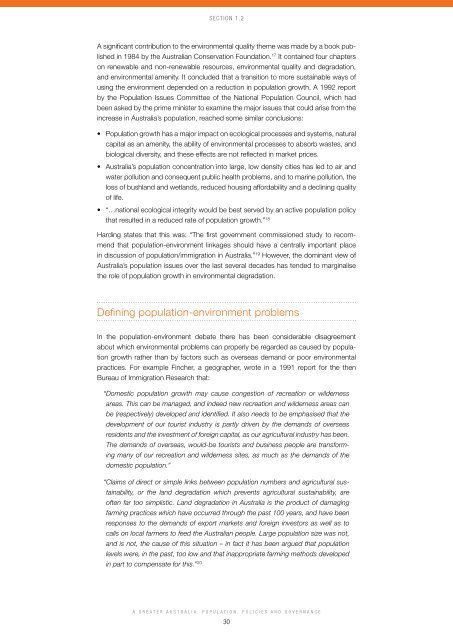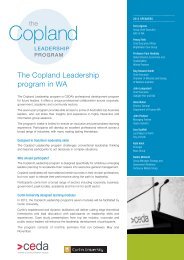A Greater Australia: Population, policies and governance - CEDA
A Greater Australia: Population, policies and governance - CEDA
A Greater Australia: Population, policies and governance - CEDA
- No tags were found...
Create successful ePaper yourself
Turn your PDF publications into a flip-book with our unique Google optimized e-Paper software.
Section 1.2A significant contribution to the environmental quality theme was made by a book publishedin 1984 by the <strong>Australia</strong>n Conservation Foundation. 17 It contained four chapterson renewable <strong>and</strong> non-renewable resources, environmental quality <strong>and</strong> degradation,<strong>and</strong> environmental amenity. It concluded that a transition to more sustainable ways ofusing the environment depended on a reduction in population growth. A 1992 reportby the <strong>Population</strong> Issues Committee of the National <strong>Population</strong> Council, which hadbeen asked by the prime minister to examine the major issues that could arise from theincrease in <strong>Australia</strong>’s population, reached some similar conclusions:• <strong>Population</strong> growth has a major impact on ecological processes <strong>and</strong> systems, naturalcapital as an amenity, the ability of environmental processes to absorb wastes, <strong>and</strong>biological diversity, <strong>and</strong> these effects are not reflected in market prices.• <strong>Australia</strong>’s population concentration into large, low density cities has led to air <strong>and</strong>water pollution <strong>and</strong> consequent public health problems, <strong>and</strong> to marine pollution, theloss of bushl<strong>and</strong> <strong>and</strong> wetl<strong>and</strong>s, reduced housing affordability <strong>and</strong> a declining qualityof life.• “…national ecological integrity would be best served by an active population policythat resulted in a reduced rate of population growth.” 18Harding states that this was: “The first government commissioned study to recommendthat population-environment linkages should have a centrally important placein discussion of population/immigration in <strong>Australia</strong>.” 19 However, the dominant view of<strong>Australia</strong>’s population issues over the last several decades has tended to marginalisethe role of population growth in environmental degradation.Defining population-environment problemsIn the population-environment debate there has been considerable disagreementabout which environmental problems can properly be regarded as caused by populationgrowth rather than by factors such as overseas dem<strong>and</strong> or poor environmentalpractices. For example Fincher, a geographer, wrote in a 1991 report for the thenBureau of Immigration Research that:“Domestic population growth may cause congestion of recreation or wildernessareas. This can be managed, <strong>and</strong> indeed new recreation <strong>and</strong> wilderness areas canbe (respectively) developed <strong>and</strong> identified. It also needs to be emphasised that thedevelopment of our tourist industry is partly driven by the dem<strong>and</strong>s of overseasresidents <strong>and</strong> the investment of foreign capital, as our agricultural industry has been.The dem<strong>and</strong>s of overseas, would-be tourists <strong>and</strong> business people are transformingmany of our recreation <strong>and</strong> wilderness sites, as much as the dem<strong>and</strong>s of thedomestic population.”“Claims of direct or simple links between population numbers <strong>and</strong> agricultural sustainability,or the l<strong>and</strong> degradation which prevents agricultural sustainability, areoften far too simplistic. L<strong>and</strong> degradation in <strong>Australia</strong> is the product of damagingfarming practices which have occurred through the past 100 years, <strong>and</strong> have beenresponses to the dem<strong>and</strong>s of export markets <strong>and</strong> foreign investors as well as tocalls on local farmers to feed the <strong>Australia</strong>n people. Large population size was not,<strong>and</strong> is not, the cause of this situation – in fact it has been argued that populationlevels were, in the past, too low <strong>and</strong> that inappropriate farming methods developedin part to compensate for this.” 20A <strong>Greater</strong> <strong>Australia</strong>: <strong>Population</strong>, Policies <strong>and</strong> Governance30





